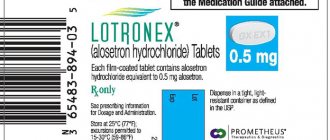pharmachologic effect
Glucose enhances redox processes in the body, improves the antitoxic function of the liver, and covers part of the body’s energy costs, as it is a source of easily digestible carbohydrates. Entering the tissues, it is phosphorylated, turning into glucose-6-phosphate, which is actively involved in many parts of the body’s metabolism.
A 40% solution is hypertonic. When a hypertonic solution is injected into a vein, the osmotic pressure of the blood increases, the contractile activity of the heart muscle increases, blood vessels dilate, the detoxification function of the liver improves, and diuresis increases.
Glucose (for injection), 10 pcs., 10 ml, 400 mg/ml, solution for intravenous administration
Glucose solution should not be administered quickly or for a long time. If chills occur during the infusion of the solution, the administration should be stopped immediately. To prevent thrombophlebitis, it should be administered slowly through large veins.
For more complete and rapid absorption of dextrose, you can administer 4-5 units of short-acting insulin subcutaneously, at the rate of 1 unit of short-acting insulin per 4-5 g of dextrose.
Patient monitoring should include regular monitoring of blood glucose concentrations, fluid balance, plasma electrolyte concentrations—particularly potassium—and acid-base balance.
It is not recommended to prescribe a glucose solution in the acute period of severe traumatic brain injury, in case of acute cerebrovascular accident, since the drug can increase damage to brain structures and worsen the course of the disease (except in the case of correction of hypoglycemia).
In case of hypokalemia, the administration of a glucose solution must be combined with the correction of potassium deficiency (due to the risk of increased hypokalemia).
For hypotonic dehydration, the use of the drug is indicated simultaneously with the administration of hypertonic saline solutions.
For diabetic patients, dextrose is administered under the control of sugar levels in the blood and urine.
In case of renal failure, decompensated heart failure, hyponatremia, special caution is required when prescribing glucose, monitoring of central hemodynamic parameters is necessary.
Use in pediatrics
It is not recommended to use 40% glucose solution in doses of more than 1 ml/kg of body weight in newborns and premature infants, since there is a high risk of developing encephalopathy caused by the administration of a hypertonic solution.
Pregnancy and lactation
Use during breastfeeding, taking into account the excess of the expected benefit for the mother and the potential risk for the child, provided that the electrolyte and fluid balance are controlled and are within physiological limits. It can be used with caution if necessary, in pregnant women with reduced glucose tolerance, under the control of blood glucose levels.
Features of the effect of the drug on the ability to drive a vehicle or potentially dangerous mechanisms.
The drug does not affect the ability to drive vehicles, operate machinery, or engage in potentially hazardous activities that require increased concentration and speed of psychomotor reactions.
Indications for use
Hypoglycemia, carbohydrate deficiency, toxic infection, intoxication due to liver diseases (hepatitis, liver dystrophy and atrophy, including liver failure), hemorrhagic diathesis; intoxication (poisoning with drugs, hydrocyanic acid and its salts, carbon monoxide, aniline, arsenic hydrogen, phosgene, etc.); collapse, shock.
As a component of various blood replacement and anti-shock fluids; for the preparation of drug solutions for intravenous administration.
Glucose (for injection), 40%, solution for intravenous administration, 10 ml, 10 pcs.
Since glucose (dextrose) tolerance may be impaired in patients with diabetes mellitus, renal failure, or those in acute critical condition, their clinical and biological parameters should be especially carefully monitored, in particular the concentration of electrolytes in the blood plasma, including magnesium and phosphorus, the concentration blood glucose. If hyperglycemia is present, the rate of drug administration should be adjusted or short-acting insulin should be prescribed.
During episodes of intracranial hypertension, careful monitoring of blood glucose concentrations is necessary.
The use of dextrose solutions can lead to hyperglycemia. Therefore, they are not recommended for administration after acute ischemic stroke, since hyperglycemia is associated with increased ischemic brain damage and impedes recovery.
Particularly careful clinical monitoring is required when starting intravenous administration of the drug. Carbohydrate solutions without sufficient electrolytes cannot be used for rehydration therapy as this may lead to significant decreases in serum electrolyte concentrations, particularly severe hyponatremia and hypocalcemia, with potentially harmful consequences for the patient, such as brain damage or heart disease. In particular, children, elderly and debilitated patients are at risk. In case of electrolyte deficiency, such as hyponatremia or hypokalemia, the solution should not be used without proper electrolyte replacement.
It is necessary to monitor the concentration of glucose and electrolytes in the blood, water balance, as well as the acid-base balance of the body.
The administration of hyperosmolar glucose solutions can lead to an increase in intracranial/intraspinal pressure in patients with impaired integrity of the blood-brain barrier.
Various conditions accompanied by metabolic disturbances (for example, after surgery or after injury, with hypoxia or organ failure) can slow down the oxidative metabolism of glucose and lead to metabolic acidosis.
Hyperglycemia should be appropriately monitored and, if necessary, controlled with short-acting insulin. Insulin administration leads to additional movement of potassium into the cells and, therefore, can cause or worsen hypokalemia.
In newborns, especially those born prematurely or with low body weight, the risk of developing hypo- or hyperglycemia is increased, therefore, during the period of intravenous administration of dextrose solutions, careful monitoring of blood glucose concentrations is necessary to avoid long-term undesirable consequences. Hypoglycemia in newborns can lead to prolonged seizures, coma, and brain damage.
Hyperglycemia has been associated with intraventricular hemorrhage, delayed bacterial and fungal infections, retinopathy of prematurity, necrotizing enterocolitis, bronchopulmonary dysplasia, prolonged hospitalization, and death.
To avoid potentially fatal overdose of intravenous drugs in neonates, special attention must be paid to the route of administration. IV infusion devices and other drug administration equipment should be monitored regularly.
Impact on the ability to drive vehicles and machinery
The use of the drug does not affect driving or engaging in potentially hazardous activities that require increased concentration and speed of psychomotor reactions.
Mode of application
Children over three years of age and adults can take the classic form of the drug, 0.5-1 tablets three times a day. If the doctor considers it necessary to prescribe a combined form of the drug (with ascorbic acid), the dosage must be recalculated, taking into account the content of vitamin C in the tablet. Typically, the dose for treatment varies from 50 to 100 mg per day 3-5 times a day.
For preventive purposes, adult patients are allowed to take up to 100 mg of the drug per day. Children 6-14 years old should not take more than 50 mg of the drug per day.
It is important to understand that the dosage and duration of therapy must be adjusted by the attending physician.
Glucose powder for the preparation of solution for oral administration 15g No. 5
Name
Glucose.
Description
White crystalline powder, odorless.
Main active ingredient
Dextrose.
Release form
Powder.
Dosage
15
special instructions
Does not affect the ability to drive a car or operate moving mechanisms.
pharmachologic effect
Diagnostic drugs. Tests to detect diabetes. Dextrose. ATX code: V04CA02.
Indications for use
An oral glucose tolerance test should be used when blood glucose levels do not allow a diagnosis of impaired glucose tolerance or diabetes.
Directions for use and doses
The patient should not reduce the amount of food they eat for 3 days before the test. Immediately before the test, the patient should not eat for 10-16 hours. The test is carried out in the morning. First, the fasting blood glucose level is determined. After this, within 5 minutes you need to drink 75 g (5 bags of 15 g) of glucose dissolved in one glass (250 ml) of water. When conducting a test in overweight individuals, glucose is added at the rate of 1 g per 1 kg of body weight, but not more than 100 g. After 2 hours, the level of glucose in the blood is determined. Children. After the first drawing of blood from a finger, the examined child takes an aqueous solution of glucose for 5 minutes at the rate of 1.75 g per 1 kg of body weight, but not more than 75 g.
Use during pregnancy and lactation
Not contraindicated.
Precautionary measures
During the test, the patient should lie or sit quietly; immediately before the test, he should not smoke, be hypothermic, or engage in physical work. The test is not recommended after debilitating diseases, operations and childbirth, during inflammatory processes, alcoholic cirrhosis of the liver, hepatitis, during menstruation, and during gastrointestinal diseases with impaired glucose absorption. Before the test, it is necessary to exclude the use of medications (adrenaline, glucocorticoids, contraceptives, caffeine, thiazide diuretics, psychotropic drugs and antidepressants), as well as medical procedures that may affect blood glucose levels. False-positive results are observed with hypokalemia, liver dysfunction, and endocrinopathies.
Interaction with other drugs
Not found.
Contraindications
Increased sensitivity to glucose.
Compound
Each package contains: glucose monohydrate – 15.00 g; excipients: citric acid monohydrate.
Overdose
With a single use of a large amount of the drug, digestive disorders (nausea, bloating, diarrhea) may occur. Symptomatic therapy is recommended.
Side effect
Not registered.
Storage conditions
In a place protected from moisture at a temperature not exceeding 25 °C. Keep out of the reach of children. Shelf life: 2 years. Do not use after the expiration date stated on the package.
Buy Glucose powder for the preparation of oral solution 15g No. 5 in the pharmacy
Price for Glucose powder for the preparation of oral solution 15g No. 5
Instructions for use for Glucose powder for the preparation of oral solution 15g No. 5
Contraindications to the use of Glucose
Glucose solution is contraindicated in patients who suffer from:
- hyperglycemia
- decompensated diabetes mellitus
- hyperosmolar coma
- impaired glucose utilization in the postoperative period
- hyperlactic acidemia
Intravenous administration of Glucose is carried out with caution when:
- chronic renal or heart failure
- hyponatremia
- Glucose tablets are contraindicated for:
- diabetes mellitus
- overhydration
- cerebral edema
- pulmonary edema
- circulatory diseases in which there is a high risk of pulmonary or cerebral edema
- acute left ventricular failure
Where does glucose come from?
Blood glucose reserves appear not only from food consumed.
If glucose levels begin to fall, the body will launch mechanisms to break down strategic reserves. Certain enzymes remove glucose molecules from the glycogen chain (stored in the liver) and send them into the bloodstream. Thanks to this process, normal glucose levels are maintained in the body.
It is important to know that after hypoglycemia, sharp jumps in plasma glucose levels often occur, which are very difficult to deal with.
The body also extracts glucose from fat reserves, but this process is lengthy. This method is used during heavy exercise or prolonged fasting.

